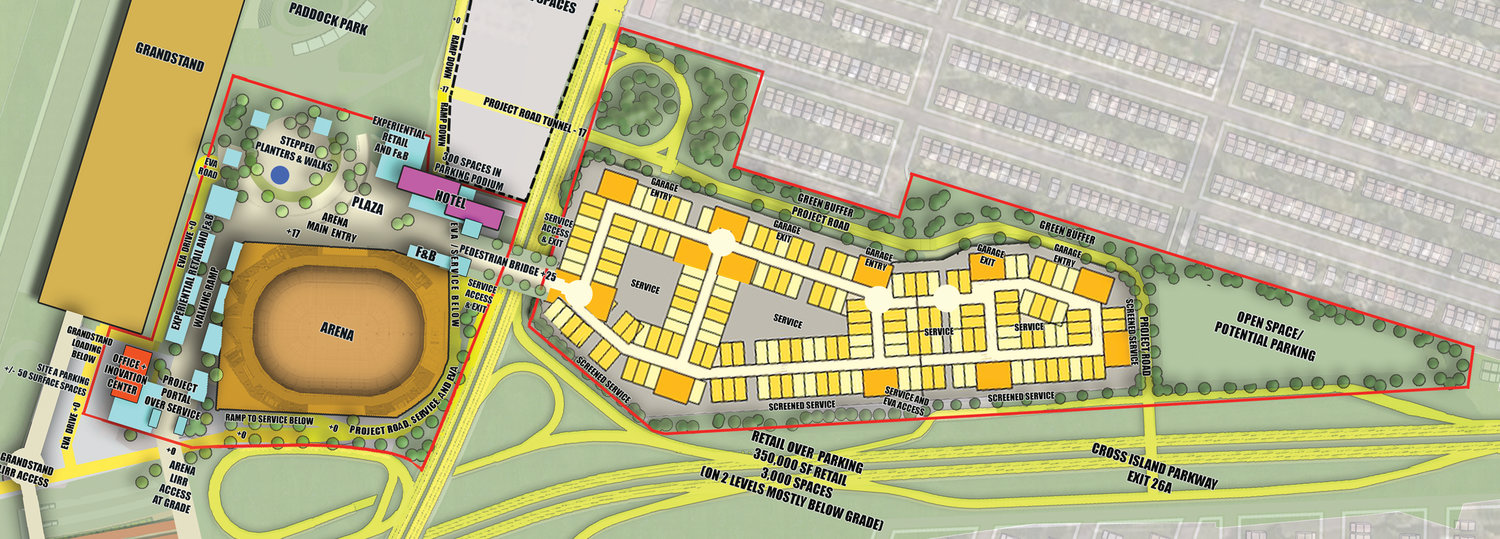Nassau studies Belmont
County officials outline arena concerns
The Nassau County Department of Public Works submitted on March 1 a comprehensive list of questions and concerns to Empire State Development regarding the proposed Belmont arena project.
While County Executive Laura Curran has said she ultimately believes that the arena project would be a substantial economic boost for the county and local residents, she and other officials, particularly in DPW, have asked that arena developers make sure that the project’s final Environmental Impact Statement finds solutions for some of the most troubling problems highlighted when a draft of the statement was released in December.
“It is our view that the necessary examination and resolution of the critical issues of community impact, including traffic and transit, can and must be accomplished within the context of the State’s Environmental Impact Statement,” Curran wrote in her letter to ESD.
Spacing and water issues
The county’s comments began in the realm of zoning, reminding developers to maintain the mandated separation between the development site and adjacent homes in Elmont and Floral Park. Local residents had expressed their own concerns for the past year about the need for a wall or berm installed along the perimeter of Belmont Park so as to spare neighboring homes from light and sound pollution.
DPW officials also expressed worry in their comments about the proposed reduction in size of the Belmont Backyard area, which it called “an integral feature of Belmont Park over the years,” saying that it has become a recreational spot for children, and that it needed more space than seven acres proposed by developers. The county has asked developers to keep the Backyard at an appropriate size or relocate it to another section of Belmont Park.
Another major issue the county has said it would like to see addressed is the arena’s use of county drainage resources. Contrary to the draft impact statement’s findings, large portions of Belmont’s lots fall outside the county’s storm water basin drains and are instead served by the Elmont Drain System, which county officials warned is already at capacity. They advised that developers redirect stormwater from the east and south lots to a 66-inch pipeline near the Cross Island Parkway to connect it to county drainage systems.
“This improvement would benefit the surrounding community of Elmont by reducing periodic flooding,” DPW officials wrote.
Additionally, the county has asked for Belmont’s developers to look into the possibility of adding an additional stormwater basin to alleviate flooding in Floral Park. Adrienne Esposito, of Long Island’s Citizens Campaign for the Environment, had previously criticized the project’s draft impact statement in regards to water resources. She said that the final statement needed to be detailed in its research and thoroughly explain how water will be used and disposed of throughout Belmont.
“What you have here now is bad,” Esposito told ESD officials during a public hearing. “The chapter on Water Resources is woefully anemic ... and offers no facts on the conclusions it made.”
Traffic woes and advice
Echoing the concerns of local residents, the county DPW officials asked Empire State Development to broaden the scope of its traffic study in the area. The county wants full studies to be conducted on Dutch Broadway, Elmont Road, Plainfield Avenue and Tulip Avenue, roads which are likely to become high-volume alternate routes drivers will take when trying to bypass traffic to Belmont Park, and added in its comments that other local roads might also become inundated with cars seeking to escape the traffic on the Cross Island Parkway, which already experiences major congestion during weekday peak hours.
Officials said they also believed that Empire State Development was being “too conservative” with some of its estimated attendance numbers. Belmont is poised to host about 145 non-hockey related events a year, with only 50 events set to draw a full, 19,000-seat, house. But county officials said that some of the other 95 events might still generate significantly high attendance numbers, and developers needed to account for that.
While the county did discuss the need for a full-time Long Island Rail Road Station at Belmont, a topic the Herald has reported on throughout the arena project’s development, Nassau officials were chiefly concerned over the arena’s impact on bus service. With traffic congestion on Hempstead Turnpike virtually guaranteed with the arena, the county asked developers for about $255,000 a year to fund an additional eight buses to help battle the inevitable delays.
“The N6 is one of the busiest suburban routes in the U.S., carrying over 18,000 people a day,” the DPW officials wrote. “NICE Bus is concerned that the [current] traffic plan doesn’t consider the heavy volume of east-west commuter traffic, which could potentially cause significant delays for bus passengers during major events.”
The county also wanted to see a type of bus hub added to Belmont, similar to the ridesharing drop-off station developers proposed for the site.
Empire State Development officials said they have been in contact with the county since the arena project’s inception in 2017. Jack Sterne, a spokesperson for ESD, said that they were continuing to work with all stakeholders during the environmental impact statement process in order to ensure the success of the project.
“We are listening to input from residents, elected officials, and community leaders – and these concerns have been heard loud and clear,” Stern said. “ESD continues to explore the possibility of a full-time train station at Belmont, in addition to traffic mitigation efforts.”
While ESD officials reiterated that the statement and the arena project were still on schedule, with construction set to begin sometime in May or June, Elmont-resident Tammie Williams, of the Belmont Park Community Coalition, doubts that the project can maintain its current timeline.
“We don’t see how ESD can address the County Executive’s concerns in the short timeframe they have allowed for mitigation” Williams said. “ESD has to go back to the drawing board, or we are headed for an epic disaster.”

 44.0°,
Mostly Cloudy
44.0°,
Mostly Cloudy 




